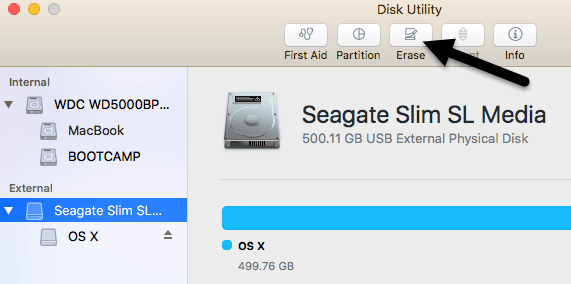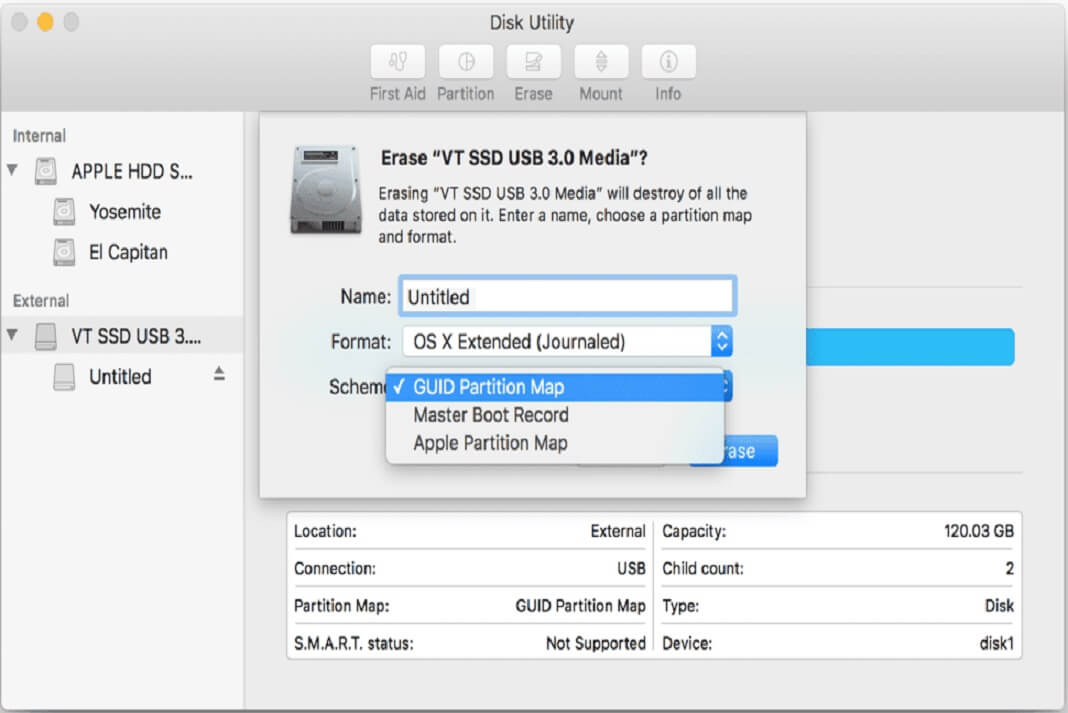- Benefit Of Different Mac Os Formats For External Hard Drive Software Download
- Benefit Of Different Mac Os Formats For External Hard Drive 500 Gb
When you do that, you should see at least four icons. In my case, I have five because I have Windows installed using Boot Camp. Anyway, the grey MacBook and Recovery 10.11.2 icons are for my internal OS X and the orange OS X and Recovery 10.11.3 are for the version installed on my external drive. Use the arrow keys to select which drive to boot from and then simply press Enter. Format Hard Drive (Mac) 1. Connect the external hard drive to the computer. Click Go on the top tool bar, and select Utilities. Open Disk Utility. Select the external hard drive on the left-hand side. Click the Partition tab. Change the Partition Layout from Current to 1 Partition.
Jun 08, 2020 • Filed to: Solve Mac Problems • Proven solutions
Most of the people in the world prefer using a Windows PC. And the Windows system uses a different file system which is known as Fat32. Usually, the Fat32 drive can be read and written by macOS, but it is not considered optimal. Even if you try to format Fat32 drive on Mac, you might end up causing more issues. So, if you have got your hands on a drive which is formatted as Fat32 of any other format instead of Mac OS Extended or APFS, then you should go through this article.
Here, we are going to learn the procedure to format a USB drive and an external hard drive on Mac. Even if you want to reformat the drive on Mac, we have all the answers for you.
Part 1. Overview of Formatting Drive on Mac
Formatting isn’t just a process of erasing the existing data on a drive. It is done as a routine maintenance task. But if you want to ensure that the drive has a complete Mac compatibility, then you’ll have to format the drive using the Mac OS Extended filesystem. It is possible to read and write on a drive which has a different file system. But unless you format the drive on Mac, it can’t be used as a bootable disk or with Time Machine.
Unless you intend to use the drive for file exchange between Windows and Mac, the formatting would be the right thing to do. Here are some other factors that will conclude that formatting the external drive with Mac is necessary as it will also improve the performance of the drive.
- To remove the data from a USB drive or any other drive completely. Simply erasing the data leaves a binary print on the drive. But formatting will erase the binary data too.
- To change the Operating system. Using another OS compatible drive can make your OS vulnerable to virus, malware, and other malfunctions. Thus, formatting the drive and deleting the previous system files and settings is vital.
- To improve the performance of the drive, frequent formatting is essential.
- To remove all kinds of virus and malware, formatting works more effectively than deleting the files.
Thus, formatting the USB drive or external hard drive will get rid of any software conflict that you are facing and even glitches will disappear.
Part 2. How to Format a Hard Drive on Mac?

Now you can understand that there are several benefits of formatting a drive. Technically, when you want to switch a USB or hard drive system to another OS, it is termed as reformatting. It allows the users to reinstall OS and all other software once the format is complete. It is considered as a better process as it is comparatively easy to format the drive for Mac instead of removing files which are malfunctioning. So, from here on, reformat will be considered as a format.
So, here is the process by which you can format hard drive or USB for Mac. The same procedure is followed for all other storage devices too.
- Connect the hard drive or USB with Mac and open Disk Utility from Applications.
- Locate the drive from the left side panel of Disk Utility and open it.
- Now switch to the Erase tab and click on the Format drag-down menu. Choose the Mac OS Extended (Journaled) option.
- Change the name of the drive if you want to and finally tap on the Erase option at the bottom of the interface.
A popup window will appear and ask you to confirm the action. As you press the Erase button, everything on the drive will be deleted completely. If you are formatting a small flash drive or USB drive, the process will complete quickly. But if you are formatting a big size hard drive, then the process might take longer than you expect. And make sure that you don’t close the Disk Utility before the process finishes.
Part 3. The Best Format Choice of External Drive on Mac
Using the external drive on Mac is a good idea as it provides additional storage. But it is hard to pick the suitable format as it depends on your usage. So, it is better that you know your options and understand which format is right for you. So, here are the best formats for an external hard drive for Mac. You can choose from a variety of file systems.
1. Apple File System (APFS):
All new Macs come pre-installed with this file system. It is optimal for use if you prefer using a Solid State Drive or flash drive. But it is also compatible with the mechanical hard disk drives too. If you don’t want to use the drive with Windows OS, then you can pick this format.
- Fast copy and paste
- Better organization of data
- Improved metadata handling and focus on the encryption
2. Mac OS Extended (HFS+):
This format means Hierarchical File System plus. This was the main file format for MacOS before APFS was released. You can reformat USB on Mac to this format easily. This format is suitable for both mechanical and SSD. This format can’t be accessed by Windows and if you want to do that, you’ll need an additional program.
3. exFAT (Extended File Allocation Table):
This format is designed to overcome the limitation of format fat32 on Mac. By using this format, you can easily share the content between Mac and Windows.
- Read and write feature compatible with Mac and Windows OS
- Ideal for flash storage and External drives.
4. MS-DOS (FAT):
It is the FAT32 format on Mac and it is labeled as MS-DOS (FAT). This format is only ideal for old computers. If you need to transfer the files from an old computer, then you can switch to this format. Otherwise, you’ll have to deal with its limitation. It is only good for Windows XP, so, you better avoid it for Mac.
As you can see, using the APFS or HFS+ format for Mac is ideal to avoid complication with your data files.
Part 4. How to Format USB to FAT32 on Mac?
process, make sure that you have made a backup or extracted the files of the drive.
Method 1. With Disk Utility:
- Connect the USB drive to Mac and launch Disk Utility from Application. On the left side panel, you will see the USB drive name.
- Click on the USB name and switch to the Erase Tab. There, you will see the Format option where you have to select the MS-DOS (FAT) format and Master Boot Record scheme.
Finally click on the Erase button and the USB drive format will complete.
Method 2. Using Mac Command Line:
- Connect the USB drive to Mac and press CMD + Space key to run Spotlight. Type Terminal in the search bar and hit Enter.
- When the Terminal window opens up, type diskutil list and you’ll find out which is your USB drive.
- Type the command sudo diskutil eraseDisk FAT32 MBRFormat /dev/disk2 where
- Sudo is the user right
- Diskutil call the disk utility program
- EraseDisk command is to format
- FAT32 set the file system
- MBRFormat commands the Disk utility to use Master Boot Record to format.
- /dev/disk2 is the location of your drive.
Wait for the process to finish and type diskutil list again to check whether formatting is done correctly or not. Now, you can use the USB with the FAT32 file system on Mac.

Video Tutorial on How to Format a USB Flash Drive on Mac
Part 5. How to Recover Formatted Data on Mac?
You will need a strong and reliable data recovery tool for this and Recoverit is the perfect answer. This software is specifically designed so that the users can restore the files that are lost from their system. Recoverit Data Recovery for Mac makes is convenient to get them back. It has a wide array of format and file support. Plus, you can perform selective recovery along with the deep scan mode which has a 96% success rate.
You can download and install the software from the official website. Once it is installed, you can follow the steps below to recover the lost word files on Mac:
Step 1: Select the Recycle Bin Recovery mode
Launch the software and specify the location on the drive where you want to look for the lost files. In case you don’t know the exact location, choose the “i can find my partition” option and hit the Start button.
Step 2: Scan the Location
The software will scan the Mac drive to look for lost or deleted files. Once the scan is finished, the results will be displayed on the screen. The files will be sorted out according to their formats. Now you can select the files.
Step 3: Preview and Recover
Click on the file to have a preview and make sure that it is not damaged. You can perform multiple selections with this tool. After you’ve selected all the files, you can tap on the Recover option at the bottom of the screen.
So, you now know what you can to do if you ever lost your important files on Mac. However, while you are saving recovered screenshots on Mac, don’t save them to the location from where they get lost.

As you can see, it is easy to format USB for Mac and Windows both. As Windows OS is more common, people know a thing or two about it. But Mac OS seems complicated to them. Once you get familiar with the OS, it is not that hard. And if some error arises or anything goes wrong, Recoverit is always here to retrieve your lost data.
What's Wrong with Mac
- Recover Your Mac
- Fix Your Mac
- Delete Your Mac
- Learn Mac Hacks
Some people are asking for a way to format a hard drive for Mac. Whether you are trying to backup Mac to an external hard drive, wipe out any personal information and sell the computer, or even use a new operating system, you need to format the hard drive on your Mac or PC.
But before you can do anything, you need to make it clear that the hard drive you want to wipe or format would be an external hard drive or an internal hard drive. We can easily format external hard drive for Mac. But when it comes to format internal hard drive for mac, things are getting a little more complicated. Maybe we will go through with the way to format a startup drive for Mac later. But now in this guide, we will cover the situation of formatting an external hard drive in steps.
Notice that you need to backup your importanct files on the hard drive you are going to format as the procedure would delete all of the data and bring it back to the factory settings.
Format an external hard drive for Mac
How to Format External Hard Drive for Mac
If you are trying to format Mac external hard drive, you can go over the process step by step:
Step 1. Connect your hard drive to your Mac.
Step 2. Open Finder and choose 'Applications > Utilities > Disk Utility' to launch the app on your Mac.
Step 3. Once you open the Disk Utility app, you can see all the drives on your Mac are listed on the left-hand sidebar. Just select the one you want to format and click on the 'Erase' tab.
Format an external hard drive for Mac
Step 4. Now in this interface, you will see a 'Format' option. In this drop-down box, you are allowed to choose different format.
OS X Extended (Journaled) should be selected if you are going to use the drive as a system or 'boot' drive on macOS.
Mac OS Extended should be selected if you will be using the drive as a media or 'scratch' drive on Mac.
Mac OS (FAT) is compatible with both PC and Mac platforms. However, there's a limit to transfer files within 4GB.
ExFAT is similar with Mac OS (FAT) but it can work with files as large as 16EB (exabytes)
So if you are going to use an external drive for both your Windows PC and your Mac, you should choose the ExFAT or FAT format.
Choose format for hard drive
Step 5. Name your drive you like but it would be better to choose something specific, so that you can make things clear every time when you look at its name.
Step 6. Click on the 'Security Options' button and you are able to choose the way (fastest or more secure) to format your external disk. The fastest way will save your time but it erases the drive only by removing the header information. That is to say, you can easily restore the hard drive using a data recovery software if the files haven't been overwritten. It is not good and the format process is meaningless in some way. So maybe you can try the more secure one. It may take quite a long time, but it will erase the drive in a deeper way.
Step 7. Click on the 'Erase' button to start erasing the external hard drive or USB. Formatting a hard drive will take a while and wait for it patiently. Once the progress bar is at 100%, the job is done!
How to Recover Formatted Hard Drive on Mac
As it is mentioned above, after formatting a hard drive, all data on the hard drive will be erased. But what if you have second thought and need to recover files from the formatted drive? Is it possible to recover files from formatted drive on Mac? Yes, it is possible. But you'll need FonePaw Data Recovery, a Mac data recovery program that can recover deleted files from hard drive, SD card, USB drive even the drive has been formatted.
DownloadDownload
Step 1. Run FonePaw Data Recovery on your Mac. Remember that you should not install the application on the formatted drive. Otherwise, some of the files could be overwritten by the application.
Step 2. When the application is open, select the files you want to retrieve from the formatted drive. Tick the formatted hard drive. And click Scan.
Step 3. The application will first quickly scan some easy-to-get files on the formatted hard drive. If you need more files. Click Deep Scan to find files that are buried deeper.
Step 4. View the results by file types or path. Tick the files you need and click Recover. If you have deleted files that haven't been found, do not save the recovered files on the formatted drive. Instead, save them on other drive, such as your USB drive.
Benefit Of Different Mac Os Formats For External Hard Drive Software Download
If you have any problem when following the steps to format hard drive for Mac, please leave us a message on the comment box below!
Benefit Of Different Mac Os Formats For External Hard Drive 500 Gb
- Hot Articles
- macOS Catalina/Mojave/High Sierra Installation is Stuck or Frozen [Fixed]
- SOLVED: White Screen on Mac Computer
- Mac Won't Turn On? Here Are Fixes
- RE: How to Fix MacBook Stuck on Loading Screen
- Mac Screen Goes Black? Here's Why and How
- How Can I Fix My MacBook Won't Shut Down
- Complete Guide to Format A Hard Drive on Windows 10/8/7
- Easiest Way to Recover Files from Formatted Hard Drive
- How to Format USB Drive and Recover Files After Formatted